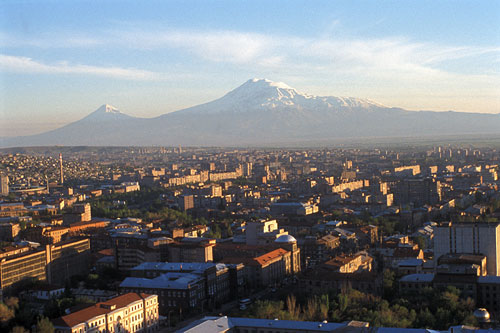
Mt. Ararat from the city of Yerevan
Armenia was converted to Christianity in 303 AD (some sources say 301) and the Apostolic Orthodox faith still includes some elements of ancient pagan practices such as rituals involving animal sacrifice. Many of the oldest and most important of Armenian churches were stationed directly above the destroyed remains of pagan sun temples. Churches and monasteries were constructed from the plentiful supply of volcanic tufa stone, which is ideal for the intricate carvings that decorate many of the churches.
Garni Temple, Armenia
Thirty-two kilometers southeast of the city of Yerevan stands the reconstructed pagan temple of Garni. The area around Garni has been settled since Neolithic times and archaeologists have found Urartian inscriptions dating back to the 8th century BC. An early temple at the site was built in the second half of the first century BC and was probably dedicated to Mithra (Mihr in Armenian), the Persian Zoroastrian god of the sun.
In the 1st century AD, the Armenian King Trdates I built the Garni temple. The temple was dedicated to Helios, the Roman god of the sun. After Christianity was adopted in Armenia in the early 4th century, most pagan monuments were destroyed or abandoned. Garni, however, was preserved at the request of the sister of King Trdates II and used as a summer residence for Armenian royalty. Several constructions and buildings have been identified within the enclosed area, including a two-story royal summer palace, a bath complex, a church built in AD 897, a cemetery, and the site's most famous and best preserved structure, a Greco-Roman temple built with 24 columns. In recent years another theory has been put forward. It has been suggested that the building may actually be identified as the tomb of an Armeno-Roman ruler, probably Sohaemus. If that were the case, its construction would be dated to AD 175. The temple was eventually destroyed in 1386 by Timur Lenk. Most of the original building blocks remained at the site until the 20th century, allowing the building to be reconstructed between 1969 and 1975.
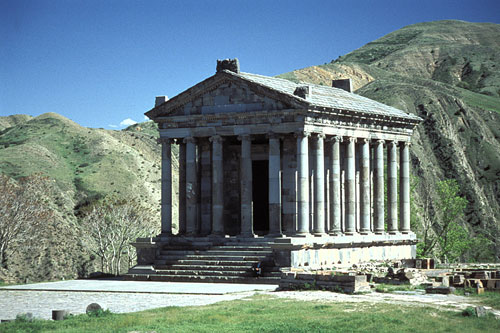
Reconstruction of ancient pagan temple of Garni
Etchmiadzin Cathedral
Twenty kilometers west of Yerevan is situated the Cathedral of Etchmiadzin, the headquarters of the Armenian Orthodox church and the most visited pilgrimage site in the country. Long before the arrival of Christianity the site was already considered a holy place. Called Vagharshapat at the end of the 3rd century BC, a Zoroastrian fire temple had been functioning there for untold centuries. Upon this fire temple a Roman Temple of Venus was later constructed and at this exact site, in 303 AD, St. Gregory the Illuminator saw the Holy Ghost descend in a vision. The name Etchmiadzin means ‘Only Begotten Descended’ and refers to the place where St. Gregory (Grigor Lusavorich) saw his vision. The first church was constructed in 309 AD upon the site of the Zoroastrian and Venus temples, and some remains of the Venus temple may be seen in the church crypt today. Etchmiadzin was the capital of Armenia from 180-340 AD. The church was rebuilt in the 6th and 7th centuries, with more recent additions in 1654 and 1868. Relics in the church collection include one of the lances that pierced the side of Christ and wood from Noah’s Arc (this wood, which has been carbon dated as 6000 years old, was supposedly given by an angel to an Armenian monk who had tried to climb Mt. Ararat three times in the 13th century).
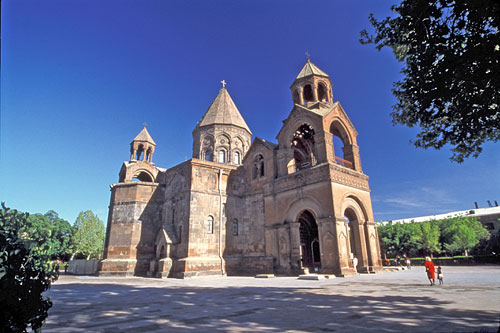
The great church of Echmiadzin, near Yerevan
Church of the Virgin Mary, Geghard Monastery
Thirty kilometers to the east of Yerevan, and nine kilometers beyond the temple of Garni, Geghard monastery is perched above the canyon of the Azat River. Centuries before the arrival of Christianity, hermits had retreated from the world and taken refuge in the region’s naturally occurring caves. According to tradition, St. Gregory the Illuminator converted these hermits and founded the first monastery in the early 4th century. No buildings have survived from these times and the oldest existing structure is the Church of the Virgin Mary, called Astvatsatsin, constructed in 1215 by the Zakarian family. In former times, the monastery has been known as ‘the monastery of the seven churches’, the ‘monastery of the forty altars’ and Ayrivank, ‘the monastery of the caves’. Each of these names gives an indication of the sizeable monastic community that had developed as more hermits’ dwellings were carved into the soft stone of the Azat canyon. The current name of the monastery, Gheghardavank, means the ‘Monastery of the Holy Lance’ and refers to one of the spears said to have pierced the body of Christ. This spear was once kept at Geghard but is now housed in the treasury of Etchmiadzin (another spear, the Spear of Longinus is kept at the Weltliche Schatzkammer of the Hofburg in Vienna, Austria). Adjacent to the Church of the Virgin Mary is a rock-hewn church with a natural spring that was known to be a holy place since long before the construction of the Geghard complex; its waters are believed to keep the skin youthful.
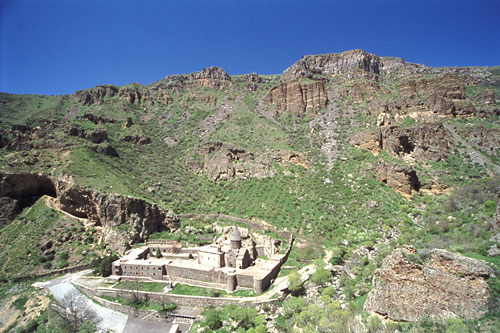
Monastery of Geghard, Armenia
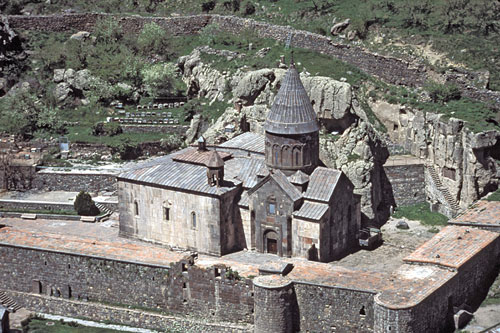
Monastery of Geghard, Armenia
Khor Virap, Armenia
Thirty kilometers south of Yerevan, the monastery of Khor Virap is built around the well shaft where, Grigor Lusavorich, who later became St. Gregory the Illuminator, was imprisoned for 13 years for practicing Christianity. King Trdates III freed Gregory from the well in 301 AD after he had cured the king of madness. This caused the conversion of the king and Armenia into the first officially Christian nation in the world in the year 301.
A chapel was initially built in 642 AD at the site of Khor Virap by Nerses III the Builder, as a mark of veneration to Saint Gregory. Over the centuries, it was repeatedly rebuilt. In 1662, the larger chapel known as the St. Astvatsatsin (Holy Mother of God) was built around the ruins of the old chapel.
The pit where Gregory was imprisoned is southwest of the main church, underneath St. Gevorg Chapel, and it is 20 feet (6 meters) deep and 14 feet (4.4 meters) wide. The pit may be visited by climbing down a long ladder.
The hill of Khor Virap and those adjoining was the site of the early Armenian capital of Artashat built by King Artashes I, founder of the Artashesid dynasty, around 180 BC. Towering above Khor Virap, and across the border of nearby Turkey, is the great sacred mountain of Mt. Ararat.
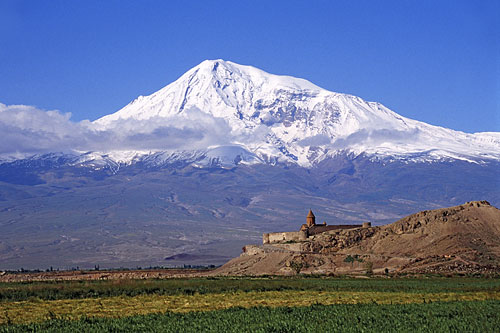
माउंट अरोड़ और खोर विराप के अर्मेनियाई ईसाई मठ
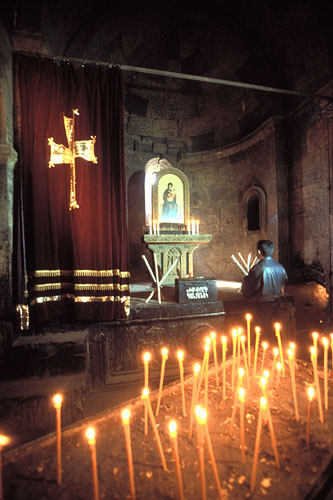
Pilgrim in the church of Khor Virap
माउंट अरारत
माउंट अरार्ट, अरक का पारंपरिक विश्राम स्थल, पूर्वी तुर्की में अर्मेनियाई और ईरानी सीमाओं के पास स्थित है। माउंट का शिखर। समुद्र तल से अरारत 5,165 मीटर (16,946 फीट) है। अरर्ट एक सुप्त ज्वालामुखी है और इसका अंतिम विस्फोट 2 जून, 1840 को हुआ था। वर्तमान में पहाड़ का ऊपरी तीसरा भाग साल भर बर्फ और बर्फ से ढका रहता है। माउंट अरारत का तुर्की नाम एग्री डागी (जिसका अर्थ है दर्द का पहाड़)। आस-पास का माउंट। अरारोट, और 4000 फीट नीचे, चोटी को लिटिल अरार्ट के नाम से जाना जाता है। शास्त्रीय लेखकों ने अरारत को बड़े पैमाने पर असम्भव माना और पहला ज्ञात सिद्धांत 1829 में एक जर्मन चिकित्सक फ्रेडरिक पैरट का था। सोवियत संघ के पतन से पहले, अर्मेनिया रूसी राज्य और तुर्की और सोवियत अधिकारियों के बीच सीमा संघर्ष का हिस्सा था। अक्सर पर्वतारोहियों के लिए पहाड़ तक पहुंच हासिल करना असंभव हो जाता था। आर्मेनिया ने अब अपनी स्वतंत्रता हासिल कर ली है, लेकिन तुर्की सरकार के साथ जारी संघर्ष और स्थानीय कुर्द जनजातियों के साथ तुर्की के अपने संघर्षों ने महान शिखर के आगे अन्वेषण को सीमित करना जारी रखा है। यदि कोई चढ़ाई करने की अनुमति प्राप्त करने में सक्षम है, तो पहाड़ के दक्षिण की ओर तुर्की शहर डोगुबायजित से शुरू करना सबसे अच्छा है। औसत पर्वतारोही जो उच्च ऊंचाई में अनुभव किया जाता है वह तीन दिनों में ट्रेक को पूरा कर सकता है, लेकिन चार या पांच दिनों की अनुमति देना बेहतर होता है ताकि शिखर की खोज को शामिल किया जा सके। अगस्त का मौसम चढ़ाई के लिए सबसे अच्छा मौसम है।
Over the years various groups have explored Ararat in the hopes of finding remains of Noah's Ark. Both Josephus in about 70 A.D. and Marco Polo about 1300 A.D. mention the Ark’s existence on the mountain, but their reports are based on others' accounts. The story of Noah's ark, as it is told in the Old Testament, is a reworking of an earlier Babylonian myth recorded in the Gilgamesh Epic. The hero of the earlier version is called Utnapishtim. It seems probable that the Babylonian story was based on a devastating flood in the Euphrates River basin, and that the ark in that story was grounded on the slopes of one of the Zagros mountains. According to Old Testament passages, God became so dismayed with the wickedness of the human race that he decided to wipe it out with a cataclysmic flood. Only a man named Noah was to be spared. So God warned Noah to build a boat to house his family and the birds and animals of the earth. Genesis (8:3-4) relates:
और पानी लगातार पृथ्वी से वापस आ गया: और एक सौ और पचास दिनों के अंत के बाद पानी कम हो गया। और सन्दूक सातवें महीने में, महीने के सत्रहवें दिन, अरारत पर्वत पर विश्राम किया।
बाइबल केवल दो अन्य मार्गों (2 राजा 19:37 और इसहाक। 37:38) में Ararat का उल्लेख करती है, जहाँ यह स्पष्ट करता है कि यह एक भूमि और एक राज्य की बात कर रहा है। बाइबल का जो शब्द हम "अरारत" के रूप में पढ़ते हैं, उसे "उरारतु" भी पढ़ा जा सकता है क्योंकि पाठ में केवल "रार्ट" है और उचित स्वरों की आपूर्ति की जानी चाहिए। उरारतु एक ऐतिहासिक राज्य का नाम था, लेकिन इस शब्द का अर्थ भी "दूर एक देश" और "उत्तर में एक जगह है।"
माउंट पर नूह के आर्क के आराम करने की कई किंवदंतियाँ और प्रत्यक्षदर्शी रिपोर्ट हैं। अरारोट लेकिन अब तक कोई वास्तविक सबूत नहीं मिला है। जमी हुई चोटी के केवल सबसे ऊंचे शिखर आर्क को संरक्षित करने में सक्षम हैं और शायद खोजकर्ता एक दिन बर्फ और बर्फ के नीचे नाव के अवशेष पाएंगे। यदि सन्दूक पहाड़ पर कम उतरा था, तो यह लकड़ी के प्राकृतिक अपघटन के कारण बहुत पहले गायब हो गया था या क्योंकि यह जलाऊ लकड़ी की तलाश में खजाने के शिकारी या पहाड़ के लोगों द्वारा दूर फेंक दिया गया था।
एक महान बाढ़ और नूह के सन्दूक के बाइबिल संदर्भ में दुनिया भर में पाए जाने वाले कई अन्य पुराणों में उल्लेखनीय समानताएं हैं। उदाहरण के लिए, ग्रीक पौराणिक कथाएं, एक भूतिया समान प्रलयकारी घटना के बारे में बताती हैं। 8 वीं शताब्दी ईसा पूर्व में दूर से समय से पहले मौखिक परंपराओं को इकट्ठा करना और रिकॉर्ड करना, ईसा पूर्व की रिपोर्ट में कहा गया है कि वर्तमान निर्माण से पहले चार पूर्व युग थे, जिनमें से प्रत्येक को भूवैज्ञानिक प्रलय द्वारा नष्ट कर दिया गया था। इन पिछले युगों की शुरुआत में, ड्यूकालियन को एक आसन्न बाढ़ के प्रोमेथियस द्वारा चेतावनी दी गई थी और उसने एक लकड़ी के बक्से को फ़ैशन करने के लिए कहा था जिसमें वह और उसकी पत्नी पिरथा बढ़ते पानी के ऊपर तैर सकते थे। नाव में नौ दिन और रात के बाद, Deucalion पवित्र माउंट पर आराम करने के लिए आया था। ग्रीस के पारनासस ने और ज़ीउस की मदद से इंसानों को फिर से पाला। जैसा कि इब्रानियों ने नूह को देखा था, इसलिए प्राचीन यूनानियों ने भी देउलियन को अपने राष्ट्र के पूर्वज और कई कस्बों और मंदिरों के संस्थापक के रूप में देखा।
एक महान बाढ़ (या बाढ़) का विचार जिसने मानव सभ्यता को तबाह कर दिया, वह प्राचीन इब्रानियों और यूनानियों की मजबूत कल्पना का उत्पाद नहीं है। इन मिथकों को रिपोर्ट के रूप में समझा जा सकता है, वास्तविक घटनाओं की सहस्राब्दी में अलंकृत और बदल दिया जा सकता है। वास्तव में, दुनिया भर में 500 से अधिक जलप्रलय किंवदंतियों को जाना जाता है और, इनमें से 86 (20 एशियाई, 3 यूरोपीय, 7 अफ्रीकी, 46 अमेरिकी और 10 ऑस्ट्रेलिया और प्रशांत से) के एक सर्वेक्षण में, शोधकर्ता रिचर्ड एंड्री ने निष्कर्ष निकाला: 62 पूरी तरह से मेसोपोटामिया और हिब्रू खातों से स्वतंत्र थे। परम्परागत वैज्ञानिक सिद्धांत, 1830 और 1840 में बनी गलत धारणाओं पर आधारित है, इन बाढ़ के मिथकों को समुद्र के स्तर में ज्ञात वृद्धि के संदर्भ में समझाने का प्रयास करता है, जो पिछले हिमयुग की परिकल्पना के अंत और 13,000 और बर्फ के बीच बर्फ के आवरण के पिघलने के बाद हुआ था। 8000 ई.पू.
The idea of an ice age at the juncture of the Paleolithic and Neolithic eras has, however, been shown to be inaccurate. Based on extensive research from the scientific disciplines of zoology, biology, geology, oceanography, climatology, astronomy, anthropology and mythology it has been conclusively shown that there was no ice age, there were no vast glaciers covering large parts of the northern hemisphere, and consequently there was no melting of any ice caps as previously hypothesized. Readers desiring a detailed scientific discussion of this matter are advised to read the book Cataclysm: Compelling Evidence of a Cosmic Catastrophe in 9500 BC, by J.B. Delair and D.S. Allan. While it is certainly true that ocean levels did dramatically rise at this time, by as much as 80-200 feet along different coastlines, that rise was not caused by the so-called slow melting of the ice caps but rather by the massively devastating influences resulting from a large cosmic object passing close by the planet around 9500 BC. This event did, however, cause cataclysmic floods which rapidly destroyed a large percentage of global human population.
डीएस एलन, जेबी डेलेर, ग्राहम हैंकॉक, क्रिस्टोफर नाइट, रॉबर्ट लोमस और रैंड फ्लेम-एथ जैसे आधुनिक शोधकर्ताओं ने दुनिया भर में पाए जाने वाले प्रलय के मिथकों का व्यापक अध्ययन किया है और असाधारण को समझाने के लिए कुछ आश्चर्यजनक और विवादास्पद - सिद्धांतों को सामने रखा है। उन मिथकों की समानता। मूल रूप से ये सिद्धांत महान बाढ़ और उनके साथ भूवैज्ञानिक प्रलय के लिए दो अलग-अलग कारण प्रस्तुत करते हैं। एक कारण, शुरू में अमेरिकी प्रोफेसर चार्ल्स हापुड द्वारा सुझाया गया था, 9600 ईसा पूर्व का क्रस्टल विस्थापन था जो तेजी से स्थानांतरित हो गया - दिनों या हफ्तों के मामले में - लिथोस्फीयर के विशाल हिस्से (जिस पर धीरे-धीरे चलती टेक्टोनिक प्लेटें स्थित हैं) और जिसके परिणामस्वरूप। विनाशकारी भूकंप, ज्वालामुखी गतिविधि और अचानक जलवायु परिवर्तन। यह क्रस्टल विस्थापन कॉस्मिक ऑब्जेक्ट (शायद एक विस्फोट सुपर नोवा का एक टुकड़ा) के विशाल गुरुत्वाकर्षण प्रभावों के कारण हुआ था क्योंकि यह 9600 ईसा पूर्व में पृथ्वी के करीब से गुजरा था। महान पुरातनता के कुछ मिथकों को केवल इस घटना के संदर्भ में समझा जा सकता है और इच्छुक पाठकों को एलन, डेलेर, हैनकॉक और फ्लेम-एथ के लेखन में विस्तृत विश्लेषण मिल सकता है।
A second cause may be found in the cometary impacts of 7460 BC and 3150 BC. The earlier impact event, which involved seven distinct cometary bodies simultaneously crashing into seven separate ocean locations around the world, has been calculated to have developed massive waves that washed over and completely devastated almost all human civilizations situated upon or near coastal locations. A large number of ancient myths that report “seven blazing suns speeding through the sky and falling to the earth” may be understood as legendary accounts of these comets. The single cometary strike of 3150 BC, impacting the eastern region of the Mediterranean Sea is probably the event that caused the great floods recorded in the myths of ancient Sumer, Egypt and Greece. Readers interested in studying the fascinating matter of cometary impacts and their devastating effects on earth will enjoy the book Uriel’s Machine by Christopher Knight and Robert Lomas.
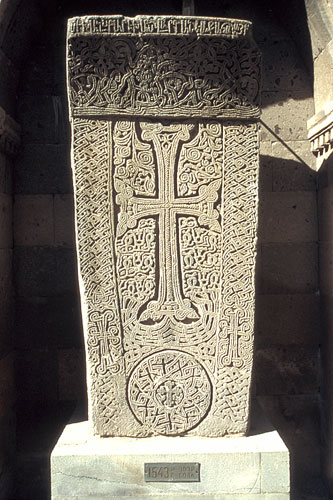
1543 Armenian cross at Echmiadzin
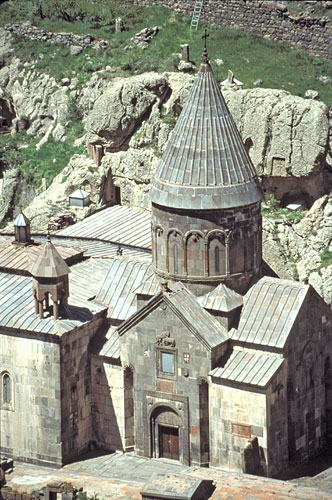
Monastery of Geghard, Armenia
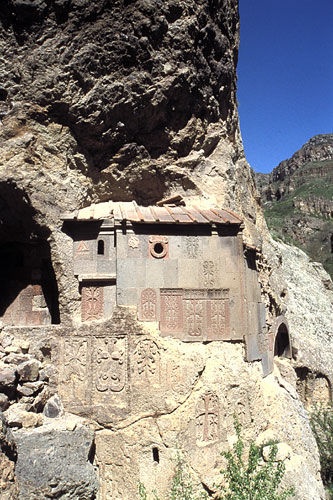
Caves of the monks, with carved rock panels, monastery of Geghard
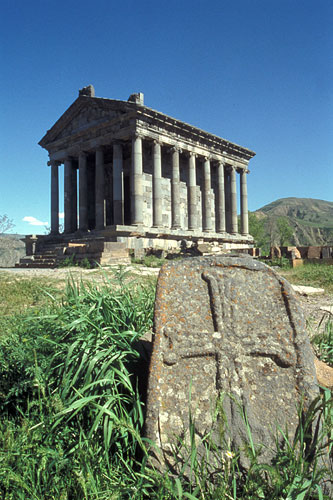
Pagan temple of Garni and old stone cross
Other Armenian sacred sites include:
- Ancient astronomical observatories of Karahundj and Metsamor.
- पंडारक के मूर्तिपूजक स्मारक
- एंगलाकोथ में डोलमेन पत्थर
- ज़ोरट पत्थर की अंगूठी
- Stone ring of Khoshun-Dash near Sissian
- The Armenian Orthodox monasteries of St. Arakelots, near Lake Sevan
- Haghartsin monastery near Kirovakan
- खड्झोंक का मठ
- ज्वार्टनोट्स का कैथेड्रल
 Martin Gray एक सांस्कृतिक मानवविज्ञानी, लेखक और फोटोग्राफर हैं जो दुनिया भर की तीर्थ परंपराओं और पवित्र स्थलों के अध्ययन में विशेषज्ञता रखते हैं। 40 साल की अवधि के दौरान उन्होंने 2000 देशों में 165 से अधिक तीर्थ स्थानों का दौरा किया है। विश्व तीर्थ यात्रा गाइड इस विषय पर जानकारी का सबसे व्यापक स्रोत है sacresites.com।
Martin Gray एक सांस्कृतिक मानवविज्ञानी, लेखक और फोटोग्राफर हैं जो दुनिया भर की तीर्थ परंपराओं और पवित्र स्थलों के अध्ययन में विशेषज्ञता रखते हैं। 40 साल की अवधि के दौरान उन्होंने 2000 देशों में 165 से अधिक तीर्थ स्थानों का दौरा किया है। विश्व तीर्थ यात्रा गाइड इस विषय पर जानकारी का सबसे व्यापक स्रोत है sacresites.com।